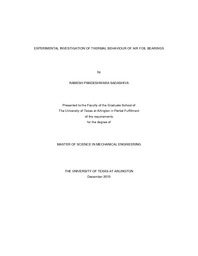
ATTENTION: The works hosted here are being migrated to a new repository that will consolidate resources, improve discoverability, and better show UTA's research impact on the global community. We will update authors as the migration progresses. Please see MavMatrix for more information.
Show simple item record
| dc.contributor.author | Pandeshwara Sadashiva, Ramesh | en_US |
| dc.date.accessioned | 2011-03-03T21:53:31Z | |
| dc.date.available | 2011-03-03T21:53:31Z | |
| dc.date.issued | 2011-03-03 | |
| dc.date.submitted | January 2010 | en_US |
| dc.identifier.other | DISS-10933 | en_US |
| dc.identifier.uri | http://hdl.handle.net/10106/5536 | |
| dc.description.abstract | Micro-turbo machinery demands gas bearings to ensure compactness, lightweight and extreme temperature operation. Gas bearings with large stiffness and damping, and preferably of low cost, will enable successful commercial applications. One of the gas bearing which is used for experimental investigation is the Air foil bearing. Previously developed test rig has been modified and further developed for investigating this bearing at various temperatures and speeds. These gas bearings are self acting hydrodynamic air bearings which have been successfully applied to a variety of turbo machinery applications. This new modified test rig also has the capability to measure bearing torque during start-up, shut-down and high speed operation. Load capacity and general performance characteristics can be measured at various temperatures and speeds. This paper describes the new modified test rig and demonstrates its capabilities at different speeds and temperatures. The present research has two phases. First phase includes design modifications and fabrication of the previously developed test rig. Second phase includes experimental investigation of thermal behavior of the air foil bearing. The bearing performance data from this test rig can be used to develop advanced turbo machinery incorporating high temperature oil-free air bearing technology. A number of tests were accomplished to find the internal temperature profile of air foil bearing at room temperature under various speeds and loads. The temperature profile was collected by instrumenting the gas bearing with multiple thermocouples in order to measure the local temperatures and evaluate thermal gradients in both the axial and circumferential direction. The tests were accomplished with and without cooling air supply. The tests with cooling air supply showed reduction in the temperature values. The cooling method introduced was an axial cooling technique wherein the cooling air is made to flow through the channels made by bump and top foil. Lateral vibration analysis of the shaft was carried out to compute critical speeds, mode shapes and undamped critical speed maps. | en_US |
| dc.description.sponsorship | Kim, Daejong | en_US |
| dc.language.iso | en | en_US |
| dc.publisher | Mechanical Engineering | en_US |
| dc.title | Experimental Investigation Of Thermal Behaviour Of Air Foil Bearings | en_US |
| dc.type | M.S. | en_US |
| dc.contributor.committeeChair | Kim, Daejong | en_US |
| dc.degree.department | Mechanical Engineering | en_US |
| dc.degree.discipline | Mechanical Engineering | en_US |
| dc.degree.grantor | University of Texas at Arlington | en_US |
| dc.degree.level | masters | en_US |
| dc.degree.name | M.S. | en_US |
Files in this item
- Name:
- PandeshwaraSadashiva_uta_2502M ...
- Size:
- 6.993Mb
- Format:
- PDF
This item appears in the following Collection(s)
Show simple item record


